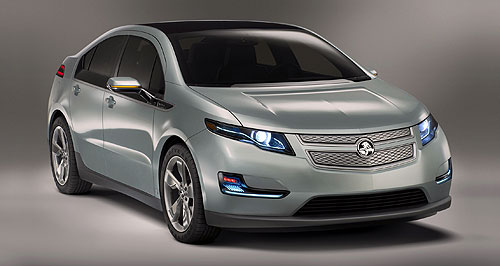Make / Model Search
News - General NewsBrand all EVs ‘zero emissions’, says FCAIHero or zero: The Holden Volt might be regarded as a zero-emission vehicle, even though it has a part-time petrol engine. Fuel test for electric cars and plug-in hybrids causes a Canberra conundrum1 Sep 2009 THE Federal Chamber of Automotive Industries (FCAI) has called on the federal government to label electric vehicles ‘zero emission vehicles’ as authorities struggle with the issue of rating the next generation of green cars. The FCAI made the call in its response to the federal transport department’s discussion paper on the treatment of electric vehicles under ADR81/02 fuel consumption testing. The industry peak body wants the new range of electric vehicles to be rated as producing zero emissions, but also suggests a disclaimer be included on the energy consumption window sticker stating the vehicle will emit no pollution if the owner opts to purchase renewable green electricity. “Research conducted by FCAI member companies indicates that purchasers of EVs are highly likely to purchase 100 per cent renewable energy,” the FCAI submission says. FCAI chief executive Andrew McKellar told GoAuto the emissions and energy use of electric vehicles should be judged using the same fuel economy test as all vehicles under the current ADR81/02 test – a short lab-based process that is extrapolated to simulate 100km of country and highway driving.  Left: FCAI chief executive Andrew McKellar. Left: FCAI chief executive Andrew McKellar.“The test is strictly factual, in that it measures what occurs in terms of emissions from the drivetrain,” he said. In other words, the FCAI is opposed to including the emissions generated by producing the electricity used to charge the electric vehicles in the fuel economy ratings. The emissions generated by electricity production varies from state to state in Australia (see separate story). Controversially, the FCAI has also called on the plug-in hybrids such as the General Motors Volt to also be deemed zero emissions vehicles. Unlike electric vehicles, plug-in hybrids run on an electric motor for a set range before reverting to a petrol engine which car companies are now referring to as ‘range extenders’. In the case of the Volt, GM expects the electric-only range to be around 64km, but this depends on a range of factors including the way the vehicle is being driven. The FCAI states that such vehicles are unlikely to be driven far enough to exhaust the batteries and therefore the potential emissions that would be generated if it switched to petrol power should not be counted. “We are proposing that plug-in hybrids be put through the same test. The test itself is quite short. It is a factual statement that driving the test cycle would result in zero emissions,” he said. General Motors was recently widely criticised for claiming the Volt would return fuel consumption figures of 230mpg (1.2L/100km) using a proposed EPA fuel test cycle, the details of which are yet to emerge. Mr McKellar said the FCAI was unaware of the test being developed by the EPA in the US and suggested that the current Australian test was valid. He said that it was reasonable to claim the Volt would not produce any drivetrain emissions because it would rarely be driven far enough to run down the battery. “In most situations, driving from home to the office and back, it would be very unlikely that the petrol motor would cut in,” Mr McKellar said. The FCAI presented data compiled by Uni SA electric vehicle specialist Dr Peter Pudney showing that 98 per cent of motorists in Adelaide drove less that 100km daily and that 87 per cent of Sydney motorists drove less than 100km per day. Dr Pudney agrees that plug-in hybrid vehicles will rarely call on their petrol back up engines, but he does not share the view that the current fuel consumption test will be valid when electric vehicles and plug-in hybrids are available next to petrol/electric hybrids and traditional combustion-engined vehicles. He said that in the case of plug-in hybrids, the emissions generated would be greatly different depending on the usage, whether the owner recharges regularly, how far they travel and the way they drive. “The emissions I get are going to vary greatly compared to someone else, much more than they would vary currently with a petrol vehicle,” Dr Pudney said. He called for a new consumption/emission standard that looked at the emissions generated during all stages of the process. This would include the emissions produced refining and transporting fossil fuels as well as those produced in the process of electricity generation. “We’ve argued that it needs to be based on the complete life-cycle of the vehicles,” he said. Dr Pudney said that any across-the-board emission comparisons should only be expressed in C02. “CO2 emissions are the only comparison that can be made across all fuel types,” he said. Dr Pudney and Uni SA are in the final stages of preparing a response to the government discussion paper. The FCAI’s submission also says that it is important that fuel consumption windscreen stickers for any electric vehicle or plug-in electric vehicle should also include its energy consumption rating expressed in watt hours (Wh) per km, as well as an estimated km range. Its proposal to include plug-in electric vehicles as zero emission vehicles could lead to some tension within the ranks of its members, with manufacturers of petrol/electric expected to be unhappy. If adopted, the FCAI proposal would mean that a Toyota Prius would continue to be rated as using 3.9L/100km, while the Volt, expected to be sold here by Holden in 2011, would be listed as using no fuel. GoAuto asked Toyota Australia how it would view such as situation, but the company declined to comment.  Read more14th of August 2009  Holden expects 1.2L/100km city economy for VoltHolden’s plug-in hybrid to offer ultra-low city economy as GM proclaims 230mpg Volt11th of August 2009  Commodore hybrid out of the VoltHolden VE hybrid hopes alive after GM announces plug-in V6 for new Buick SUV |
Click to shareGeneral News articlesResearch General News Motor industry news |










Facebook Twitter Instagram